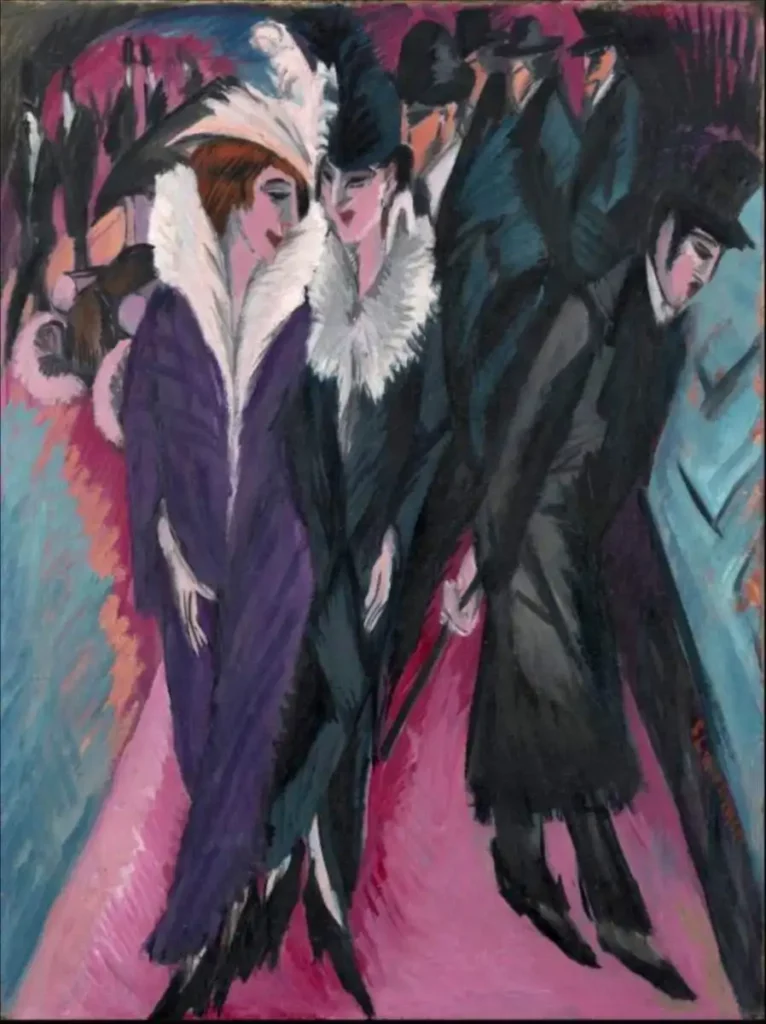During the tumultuous political and social climate of early 20th century Germany, artists found ways to express their fears and pain using a wide array of mediums.
During the first few decades of the 20th century, societal upheaval transformed Germany. The country saw a drastic metamorphosis from an empire at war to a republic at peace. As soldiers came home from the Great War and the public witnessed these rapid social changes, there was a clash of cultures at a time of transformative modernity. Urban cities were at a crossroads between the country’s violent past and modern life, fostering a new movement that sought to find meaning in this new world. The German Expressionist movement and its counter-movement, Neue Sachlichkeit, or “New Objectivity,” revolutionized Germany’s art world through painting, cinema, and architecture.
To Begin, What Was German Expressionism?

The Expressionist movement was difficult to define, as its flexible nature in and of itself made it a distinctive art movement during the first half of the 20th century. In Germany, especially, expressionism was a cultural movement that grew to encompass diverse topics, subjects, and art styles. It included a wide array of mediums within its scope: from painting to filmmaking to architecture.
In a way, German Expressionism could be more efficiently defined when compared to its predecessor: Impressionism. While using a single medium, painting, Impressionists depicted landscapes and vistas of their surroundings without constraining themselves to the strict, traditional boundaries of realism. Meanwhile, in their own works, Expressionists preferred to use their art in order to represent their emotions about the world around them. Influenced by the poignant paintings of Vincent Van Gogh (See Further Reading, Stephanie Barron, 1988, p. 10) and Edvard Munch, German Expressionism was a form of escapism and gave a space of societal commentary for its artists, who were at a crossroads between the past and the future.
German Expressionism: Painting before the First World War

Following the unification of Germany in 1871, industrialization in Kaiser Wilhelm II’s unified empire grew exponentially during the latter half of the 19th century (See Further Reading, William Otto Henderson, 1961, p. 1). Every field of study, from chemistry to communications to transportation, was transformed by a constant barrage of scientific discoveries, all powered by the recent invention of electricity. These changes, from the loneliness of city life to the dizziness of urban development, alarmed artists of the time. Everyday life seemed to be in constant flux.
During this time, two prominent artistic groups emerged. Die Brücke (See Further Reading, Rose-Carol Washton Long, 1995, p. 21) was born in Dresden in 1905, and Der Blaue Reiter was founded in Munich in 1911. Ernst Ludwig Kirchner, Fritz Bleyl, Erich Heckel, and Karl Schmidt-Rottluff were the founding members of Die Brücke (See Further Reading, Stephanie Barron, 1988, p. 10). Their works, with their bright colors and lack of traditional composition, contrasted sharply with the academic, realistic art preferred by bourgeoise society. Meanwhile, Wassily Kandinsky, Franz Marc, Paul Klee, and August Macke took part in Der Blaue Reiter. Symbolism heavily influenced their works, which were more spiritualistic in their intent.
While these artists’ masterpieces differed wildly from one another, they all painted with thick brushstrokes and represented abstract, colorful figures. These techniques were used to put the painters’ own emotions at the forefront of the mind and as conveyed by the subject depicted on the canvas.
German Painting during the First World War

The fears of modernity presented in German Expressionist art came to a head when the Great War was declared. Archduke Franz Ferdinand’s assassination thrust the world into the trenches, and Germany was an indispensable member of the Central Powers along with Austria-Hungary. Generals sent their soldiers to the battlefields to defend their country on French soil, but the horrors of the War found them there instead.
This horror, of course, had dramatic impacts on the lives of German Expressionists, especially those who enlisted. Ernst Ludwig Kirchner was taken off the front lines after a mental breakdown, and August Macke and Franz Marc were unfortunately killed in combat in 1914 and 1916, respectively.
German Expressionism in Cinema

By the end of the 19th century, a new medium had come into its own: cinema. Before the First World War, German cinema was seen as revolutionary and immoral, as movies were enjoyed by the lower working class. The upper class was threatened by this democratization and criticized cinema in its infancy (See Further Reading, Stephen Brockmann, 2020, p. 19).
By the 1910s, attitudes toward German cinema started to shift. Members of the bourgeoisie defended this medium as “a necessity for European masses who were tired of the intellectualized, abstract culture of words, logic, and philosophy,” a feast for the eyes in a world without visual stimulation (See Further Reading, Stephen Brockmann, 2020, p. 20). The beginning of the First World War, too, influenced German cinema. The foundation of the Universum Film Aktiengesellschaft fostered a protectionist environment prioritizing domestic films. Newsreels showed the front lines, and patriotic dramas attracted the public to movie theatres.
Under the Weimar Republic, German cinema became one of the biggest film industries in the world. (See Further Reading, Stephen Brockmann, 2020, p. 43) As the period between 1918 and 1929 was characterized by political uncertainties, which started with an economic crisis and ended with the start of the Great Depression, “[c]inema thus gave expression to a very real sense of change and insecurity that persisted throughout the Weimar Republic.” (See Further Reading, Stephen Brockmann, 2020, p. 45)
German Expressionism in film was defined by the mise-en-scène, in which dimly lit sets full of shadowy corners where danger lurked reflected the inner turmoil of the characters on the screen. The Cabinet of Doctor Caligari, released in 1920, and Nosferatu, released in 1922, are well-known examples of German Expressionist movies that used anxiety-inducing mise-en-scène and birthed the modern horror film genre.
Fritz Lang’s Metropolis

Produced at the height of the Weimar Republic, Fritz Lang’s film Metropolis was a direct criticism of modern capitalism. Born of a desire to showcase a future that never was against painted backdrops and the dramatic use of chiaroscuro, Metropolis represented a vision of oppressive industrialization. In Fritz Lang’s film, classes divide Metropolis. Above ground are the members of the elite, who oversee the smooth operations of Metropolis, and below ground are the working-class people, who operate the machines that make the city function. The film is centered around privileged Freder, who travels down to Metropolis’ bowels and falls for Maria, a working-class woman who wants to incite a class revolution.
When Joh Frederson, Freder’s father, and Rotwang, an inventor, use the image of Maria to create a female robot, they incite the working class into destroying their machines and flooding the underground. During the film’s climax, the working-class machine operators destroy the robot, and Rotwang falls to his death when confronted by Freder and Maria. The film closes with Got, the worker who operated the central machine, linking hands with Joh Frederson and Freder Frederson between them.
How did Fritz Lang’s Metropolis fit into the German Expressionist movement? Maria said it herself: “There can be no understanding between the hands and the brain unless the heart acts as mediator.” Within a world full of capitalistic anxieties and fears (See Further Reading, Stephen Brockmann, 2020, p. 45), Fritz Lang used the dystopian city of Metropolis to show that love, expressed by Freder Frederson’s romantic feelings for Maria, could bring together the elite and working-class people.
Between Expressionism & Objectivity: The Bauhaus & the Modern Urban Landscape

German Expressionism was also present in the world of architecture. For a time, it blossomed within the walls of one particular school founded at the time: Staatliches Bauhaus.
The Bauhaus was a school of architecture founded by architect Walter Gropius in the city of Weimar and was in operation between 1919 and 1933. Contrasted with the opulent, geometric urban landscape of Art Deco, the style of the Bauhaus school was defined by the simplicity of modern architecture.
Modernist architecture was the matter of the day and showed restraint and rationality in sleek architectural lines. The Bauhaus included architecture and craftsmanship as its many fields of study. Students were taught metalworking, cabinetmaking, weaving, poetry, typography, and wall painting in order to combine beauty and utility. Expressionist painters such as Paul Klee and Wassily Kandinsky were teachers in the Bauhaus.
The links that existed between the Bauhaus and German Expressionism are complex. Early Bauhaus works encouraged artistic expression and varied between mediums. Paul Klee encouraged his students to follow an individualistic, personal view of their art. The Bauhaus school, too, inspired the futuristic and dystopian urban landscape of Fritz Lang’s Metropolis.
But as the years went on, the Bauhaus school was soon divided. With the arrival of László Moholy-Nagy in 1923, many turned away from Expressionism and embraced Neue Sachlichkeit (New Objectivity). This new vision of architecture became synonymous with the school’s adherence to Functionalism. Affordable, functional, and reproducible forms of architecture were prioritized. They were accessible through prefabrication methods that produced buildings on a massive scale and went hand in hand with the rapid growth of urban centers. New Objectivity abandoned the lavishness and lack of geometry in early Bauhaus works and was pioneered by such artists as Walter Gropius himself.
Otto Dix, New Objectivity, & the Critics of German Expressionism

While the Bauhaus school divided, politics, too, played a role in this artistic split, especially in painting. As the Weimar Republic replaced Wilhelm II’s Empire, German art took on a satirical and ironic view of the world known as Neue Sachlichkeit, or New Objectivity. Artists such as Otto Dix heavily criticized the war, the political instability, and the economic crisis of the time.
New Objectivity turned away from subjectivity and took on a cold and distanced tone from its primary subject. (See Further Reading, Michael Karlsson Pederson, 2021, p. 58). While German Expressionism was born from the medium of painting before the First World War, its legacy was a subjective view of the world. This subjectivity was challenged by New Objectivity.
Wilhelm Heinrich Otto Dix was a fascinating figure in the New Objectivity movement. A soldier who came home after the First World War, he saw firsthand the horrors of modernity: the bombs, the barbed wires, and the incessant attacks from both sides of the front lines. Within his haunting paintings, Otto Dix dedicated his work between the wars to depicting his experiences in the trenches during the First World War with cold, distanced accuracy.
Gas masks, skulls, and the dead, disabled, or disfigured bodies of shell-shocked soldiers populated his paintings in the devastated landscapes of no-man’s-land. Dix never shied away from the atrocities he witnessed as a soldier assigned to a field artillery regiment. In his works, Otto Dix showed with chilling objectivity the anguish he had felt in the trenches.
Fascism & the Profound Hate of German Expressionism

Emblematic of the interwar period, fascism criticized German Expressionism. The Nazis hated the sensitivity and expressivity of modern art, which went against the grain of 19th-century realistic art. Nazis believed modern art laughed in the face of traditional German values, from patriotism to militarism, and encouraged controversy in its avant-garde style.
The Nazis used modern art as a scapegoat to push their ideologies and legitimize their power. Through their criticisms of modern art, they marginalized members of German society: from the intellectual elite, who were touted as out of touch with the German people; to the mentally ill, who were associated with unrealistic shapes and images; and to Jewish people and communists, who always took the blame for the ills of German society.
Censorship began when Hitler came into power in 1933. Museum directors and modern art teachers were fired. Tens of thousands of artworks were “purged” from galleries and museums. Nazis confiscated paintings purchased by Jewish clients. (See Further Reading, Anne Rothfeld, 2002). The Bauhaus school was shut down.
While German Expressionism was suppressed, Hitler and his Minister of Propaganda, Joseph Goebbels, pushed for the formation of new art, traditionalist and stagnant, that was heavily regulated by the state and reaffirmed their control over every aspect of German society.
The Nazis’ censorship came to a head with the opening of the Entartete Kunst, or the Degenerate Art Exhibition. In 1937, German Expressionist paintings (such as Street, Berlin, 1913 by Ernst Ludwig Kirchner) were exhibited in order to promote the Nazis’ disgust of modern art. Hundreds of paintings were associated with a lack of morals, societal criticisms, and antisemitic Jewish conspiracy theories. This could be seen as the end of German Expressionism as we know it.
How Did German Expressionism Live on?

Heavily criticized on all sides of the political spectrum during the 1920s and the 1930s, German Expressionism under the Third Reich as the Nazis came into power. Yet, the movement was reborn after 1945 with the rise of Abstract Expressionism and the works of Tim Burton in cinema today.
In the United States, famous painters created a brand-new movement that dug its roots in German Expressionism. Based in New York City, these Abstract Expressionist artists were divided into two groups. The action painters, which included Jackson Pollock and Willem de Kooning, conveyed impulsivity as they poured and flicked paint around on their canvases. The color field painters, including Mark Rothko, Barnett Newman, and Clyfford Still, used unconventional compositions with colorful shapes to represent a meditative, religious experience. The expressivity, creative use of color, and breaking with tradition all bore a striking resemblance to the works of German Expressionists, such as Franz Marc and Karl Schmidt-Rottluff, in their own distinctive ways.
Meanwhile, in cinema, Fritz Lang’s Metropolis influenced the realm of science fiction and the moody urban landscape of Tim Burton’s Batman, released in 1989. The dark, gloomy anxiousness of suffocating modernity that characterized German Expressionist cinema populates the alleyways of Burton’s Gotham. Many of Tim Burton’s films have also aligned with the Expressionist tradition of the first horror films. The shadows of The Cabinet of Doctor Caligari and Nosferatu haunt the nightmare-inducing sets of Beetlejuice and the Gothic make-up of Johnny Depp’s Edward Scissorhands and Danny DeVito’s Penguin. Whereas the bright colors and cheerful enthusiasm of Expressionist paintings lived on in Abstract Expressionism, it was the macabre suffering of German cinema that was mastered by Tim Burton.
What Was the Legacy of German Expressionism?

German Expressionism was a sharp response to the growing pains of an industrializing country. This new form of art found all its meaning before, during, and after the crisis of the First World War, along with the creation of the Weimar Republic. As a cultural movement, it also defined new forms of artistic expression, such as early 20th-century cinema as an art form, and revolutionized painting and architecture with modernist intent. Criticized for its utopic view of the world by New Objectivity and condemned by the Nazis, German Expressionism nevertheless survived in the works of Abstract Expressionist artists and contemporary filmmakers. In the end, the legacy of German Expressionism was the creation of a new movement that was an escape for its artists and criticized society by either showing a world of color – which early 20th century Germany lacked –- or the darkness that haunted the throes of modernity.
Source : The Collector















